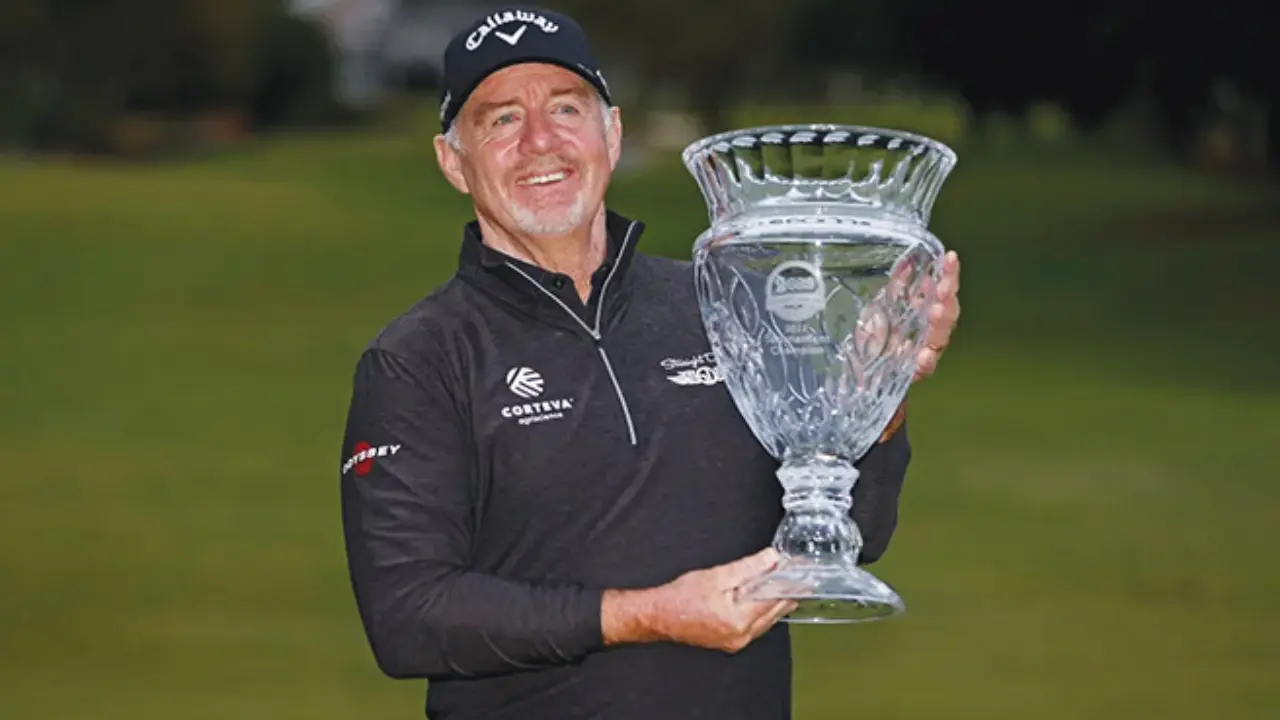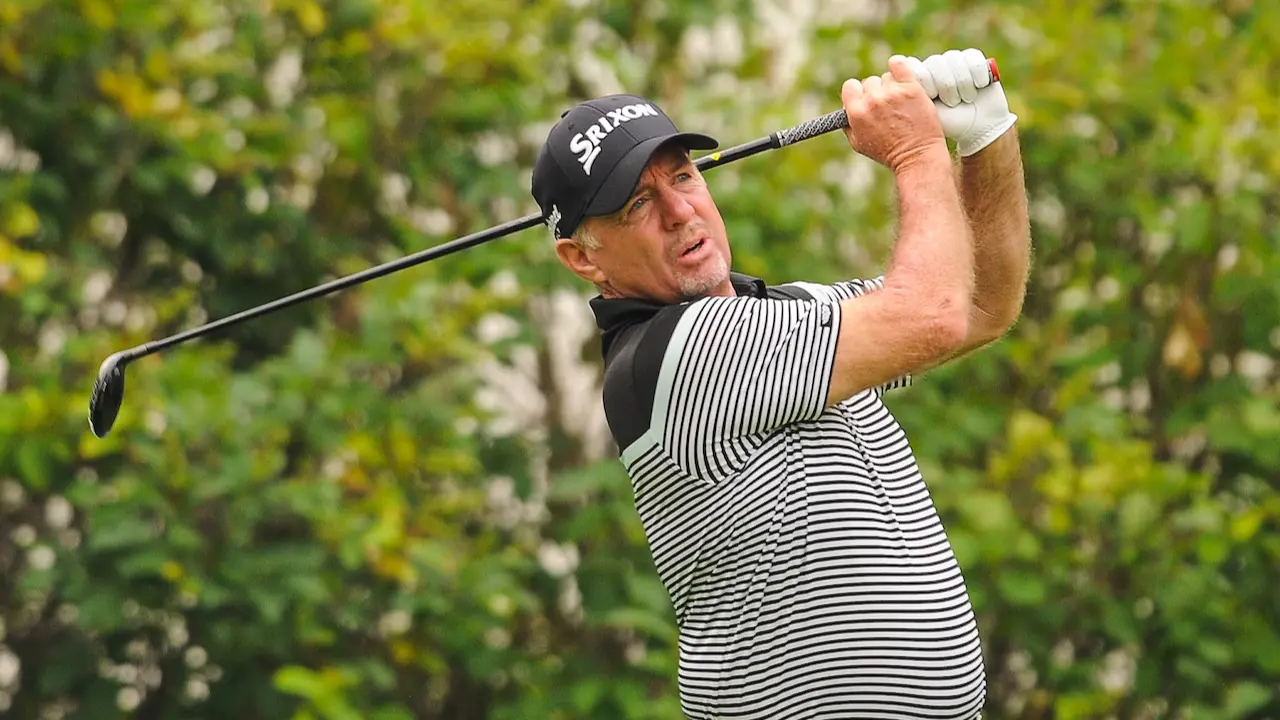Rod Pampling’s story is one of perseverance, unexpected triumphs, and a career spanning over two decades. From his humble beginnings as a Queensland greenkeeper to becoming a three-time PGA Tour winner, Pampling’s journey embodies the grit of an underdog.
This article breaks down his net worth, career highlights, endorsements, and the stats that define his legacy.
Rod Pampling’s Biography
| Category | Details |
|---|---|
| Full Name | Rodney Pampling |
| Born | September 23, 1969 (Redcliffe, Queensland, Australia) |
| Age | 55 |
| Nationality | Australian |
| Height | 5 ft 10 in (1.78 m) |
| Weight | 175 lb (79 kg) |
| Turned Professional | 1994 |
| Residence | Brisbane, Australia; Double Oak, Texas, U.S. |
| Net Worth (2025) | $16 million (estimated) |
Rod Pampling grew up in Queensland, where he worked as a greenkeeper at Caboolture Golf Club before turning pro. While details about his family, spouse, or social media profiles remain private, his career achievements speak volumes.
Early Career
Rod Pampling’s journey to professional golf began far from the spotlight. Born in Redcliffe, Queensland, he spent his teenage years working as a greenkeeper at Caboolture Golf Club, mastering the sport’s fundamentals while maintaining the course.
After completing a traineeship at Bribie Island Golf Club, he turned pro in 1994 at age 25, joining the PGA Tour of Australasia.
For years, he balanced odd jobs with tournament play, his powerful swing and work ethic slowly gaining attention. The breakthrough came in 1999 when he won the Canon Challenge, defeating future major winner Geoff Ogilvy by three strokes. This victory fueled his leap to the U.S., where he and fellow Aussie Paul Gow famously road-tripped across the country in a car, scraping by on minor tour earnings.
By 2001, Pampling’s persistence paid off: he earned his PGA Tour card through strong finishes on the Buy.com Tour (now Korn Ferry Tour), including two runner-up placements. These gritty early years shaped his resilient style, proving that even a greenkeeper from Queensland could compete with golf’s elite.
Professional Career
Rod Pampling’s PGA Tour career (2002–2019) blended thrilling victories with hard-earned resilience. His breakout moment came at the 2004 International, where an eagle on the 71st hole clinched his first PGA Tour win under the Modified Stableford scoring system. Two years later, he edged out Greg Owen at the 2006 Bay Hill Invitational, soaring to a career-high world No. 22 ranking.
While the 2010s brought challenges—including narrowly retaining his Tour card in 2011—Pampling authored a fairytale comeback in 2016. After a clerical error granted him entry into the Shriners Open, he fired a first-round 60 and held off Brooks Koepka for his third PGA Tour title, a decade after his last win.
Beyond the U.S., he claimed the 2008 Australian Masters in a playoff and notched a T5 finish at the 2005 Masters. Though major championship glory eluded him, Pampling’s $16 million career earnings and 252 cuts made (62%) reflect a legacy of grit, proving that even late-blooming greenkeepers can thrive among golf’s elite.
Rod Pampling’s Net Worth Details
Rod Pampling’s net worth is estimated to be $16 million as of 2025.
Career Earnings
| Year | Earnings | Key Highlights |
| 1998–1999 | $17,476 | Early career on Australasian Tour |
| 2002–2003 | $1,064,974 | PGA Tour rookie season |
| 2003–2004 | $1,737,725 | First PGA Tour win at The International |
| 2005–2006 | $2,664,673 | Career-best year: Bay Hill Invitational victory |
| 2007–2008 | $1,702,952 | Won Australian Masters |
| 2016–2017 | $1,539,422 | Shriners Open win after a clerical error entry |
| 2024 | ~$23,887 | Earnings from PGA Tour Champions events |
| Total | $16,039,993 | Over 408 tournaments played (PGA Tour) |
Endorsements
Rod Pampling’s endorsement portfolio has stayed relatively low-key compared to golf’s superstar earners. His longest-known partnership is with AdvoCare, a health and wellness brand that sponsors athletes focused on fitness and endurance—traits Pampling exemplified during his 18-year PGA Tour grind.
His consistent presence on leaderboards and reputation as a hardworking “everyman” golfer likely attracted regional brands in Australia and the U.S., particularly during his peak years (2004–2008).
Unlike many peers, Pampling avoided flashy sponsorship logos, keeping his branding subtle. This aligns with his understated persona, proving that even without mega-deals, resilience and authenticity can build a sustainable career—both on and off the course.
Career Stats
| Category | Stats |
| Tour Wins | |
| PGA Tour | 3 (2004 International, 2006 Bay Hill, 2016 Shriners Open) |
| European Tour | 1 (2008 Australian Masters) |
| PGA Tour of Australasia | 2 (1999 Canon Challenge, 2008 Australian Masters) |
| Web.com/Korn Ferry Tour | 1 (2015 BMW Charity Pro-Am) |
| PGA Tour Champions | 2 (2021 Boeing Classic, 2023 SAS Championship) |
| Major Championships | |
| Masters Tournament | T5 (2005) |
| U.S. Open | T14 (2008) |
| The Open Championship | T27 (2004, 2007) |
| PGA Championship | T14 (2003) |
| Senior Major Championships | |
| U.S. Senior Open | 4th (2021) |
| Senior Players Championship | T5 (2020) |
| Career Cuts Made | 252/408 (62%) on PGA Tour |
| Highest World Ranking | 22 (June 2006) |
| Career Earnings | ~$16 million (PGA Tour, Champions, endorsements) |
FAQs
1. When was Rod Pampling born, and where is he from?
Rod Pampling was born on September 23, 1969, in Redcliffe, Queensland, Australia. He grew up working as a greenkeeper at Caboolture Golf Club, which laid the foundation for his golf career. Pampling later split his residence between Brisbane, Australia, and Double Oak, Texas, during his PGA Tour years.
2. When did Rod Pampling turn professional?
Pampling turned professional in 1994 at age 25. He initially played on the Australasian PGA Tour, winning his first event in 1999. His early career included grinding on minor U.S. tours before earning his PGA Tour card via the Buy.com Tour (now Korn Ferry Tour) in 2001.
3. How many PGA Tour wins does Rod Pampling have?
Rod Pampling has three PGA Tour wins: the 2004 International, the 2006 Bay Hill Invitational, and the 2016 Shriners Hospitals for Children Open. His 2016 victory came after a clerical error granted him entry, marking his first PGA Tour win in over a decade.
4. What is Rod Pampling’s net worth?
Rod Pampling’s estimated net worth is $16 million. This includes career earnings of $16.03 million from tournaments and endorsements, primarily from his long-term partnership with health brand AdvoCare and sponsorships during his PGA Tour peak.
5. Who is Rod Pampling’s spouse?
Rod Pampling married his wife, Angela, in 1999. The couple spent their early years traveling across the U.S. in a car while Pampling competed on minor tours. They maintained a low profile, with Angela rarely appearing publicly during his career.
6. What was Rod Pampling’s most notable career comeback?
His 2016 Shriners Open win was a career-defining comeback. After a clerical error allowed him into the event, Pampling shot a first-round 60 and held off Brooks Koepka for his third PGA Tour title—a decade after his previous win—extending his PGA Tour career until 2019.
7. Which endorsement deals has Rod Pampling secured?
Pampling’s primary endorsement was with AdvoCare, a health and wellness brand. While other sponsorships remain private, his consistent performance and “everyman” reputation likely attracted regional Australian and U.S. brands during his peak years (2004–2008).
8. What are Rod Pampling’s career earnings?
Pampling earned $16.03 million over 408 PGA Tour events. His highest-earning season was 2005–2006 ($2.66 million), driven by his Bay Hill Invitational win. Later, PGA Tour Champions events added modest earnings, including $1.22 million in his 2023 rookie season.
9. How did Rod Pampling perform in major championships?
Pampling’s best major finish was T5 at the 2005 Masters. He also placed T14 at the 2008 U.S. Open and 2003 PGA Championship. Despite no major wins, his consistency earned him a career-high world ranking of 22 in 2006.
10. What is unique about Rod Pampling’s golf swing technique?
Pampling’s swing, coached by Gary Edwin, emphasizes a “right-sided” approach with minimal body rotation and early wrist set. This technique prioritizes arm power over torso rotation, allowing precise ball-striking. He used TPT Golf shafts for consistency, notably during his 2016 Shriners Open victory.














